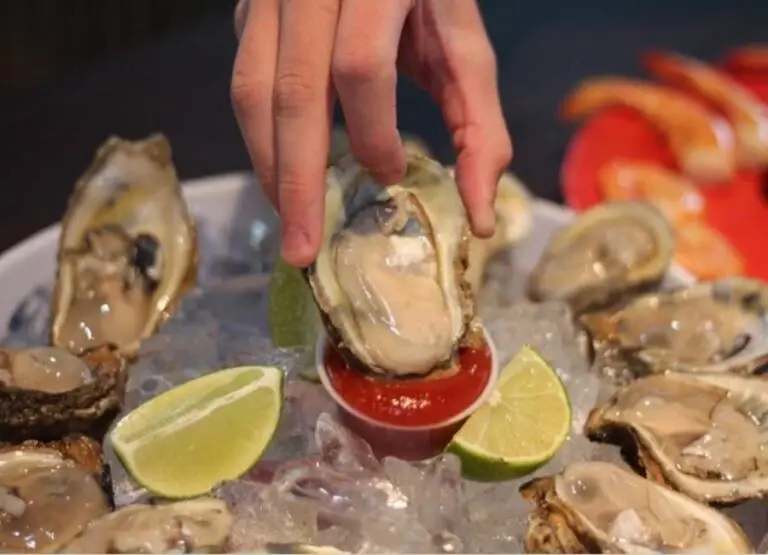How To Know Lobster Is Bad [Answered]
Seafood enthusiasts all around the world savor the delicious delicacy of lobster.
It is understandable why lobster is a mainstay of many high-end dining experiences given its sweet, juicy flavor and soft flesh.
But it’s crucial to understand when your lobster has gone bad, just as with any perishable food item.
Consuming rotten lobster can cause major health issues and ruin your meal.
We’ll go through the telltale indications and symptoms of rotten lobster in this blog article, along with advice on how to always serve and consume fresh, healthy seafood.
This guide can assist you in making knowledgeable judgments regarding your seafood choices, whether you’re a seafood aficionado or simply seeking to enjoy a delectable lobster supper.
How To Know Lobster Is Bad
The easiest approach to determine whether a lobster is rotten is to look for stains in the meat, an off-flavor, and evidence of decomposition like slime or mildew.
Additionally, it’s crucial to make sure the lobster is still alive because a dead lobster spoils rapidly.
The lobster should be animated and responsive if it is still alive.
It is advisable to throw it away if it is not. In addition, the meat of the cooked lobster should be firm rather than rubbery.
It is better to throw the lobster away if the meat is mushy or squishy.
Signs and Symptoms of Bad Lobster
Here are some common ways to identify a spoiled lobster which can lead to Lobster food poisoning:
- Cracking of the shell: A cracked or fractured lobster shell indicates that it is no longer fresh and may have begun to rot. The lobster’s shell serves as protection for the flesh within, therefore if it is broken, it is no longer fresh and can be contaminated with dangerous bacteria.
- Bacterial growth: The presence of white or yellow spots on the lobster indicates that it is no longer fresh and may be contaminated with hazardous germs. Bacterial growth indicates that the lobster has been dead for some time and might not be suitable for consumption.
- Softshell: A soft shell is an indication that the lobster is beginning to go bad and might potentially contain dangerous pathogens. Fresh lobsters have hard, firm shells; however, if the shell is soft, the lobster has likely been dead for some time and might no longer be suitable for consumption.
- Off-flavor: If the lobster tastes metallic or has an off-flavor, it is likely no longer fresh and may contain dangerous pathogens. If the flavor of the fresh lobster is odd, it is advisable to avoid eating it. Fresh lobster should have a gentle, pleasant taste.
- Unpleasant odor: The aroma of fresh lobster should be faint and somewhat sweet. The lobster is no longer fresh and may have begun to rot if it has a strong, fishy smell. The lobster may be contaminated and hazardous to eat if it has an unpleasant odor that is brought on by bacteria and other germs.
- Slimy texture: If the lobster has a slimy texture, it is no longer fresh. The accumulation of germs and other microbes that results in sliminess might render the lobster dangerous to consume.
- Cloudy eyes: A lobster’s eyes are a reliable sign of its general health. Fresh lobster has clear, glassy eyes, whereas eyes that are murky or sunken suggest that the lobster is no longer fresh and may have begun to rot. To lower the danger of food illness, it is preferable to avoid eating lobster if its eyes are hazy.
- Discoloration: The lobster’s shell’s discoloration is a symptom that it is beginning to deteriorate. While lobsters that have started to rot may be brown, yellow, or gray in appearance, fresh lobsters should have a brilliant, red color. The lobster is no longer fresh and may contain dangerous germs if it has discolored.
- Inactivity: Live lobsters should be moving their claws and being active. They are no longer fresh and may have begun to deteriorate if they are inactive. Inactivity may indicate that a lobster has died and may no longer be suitable for consumption.
How to Store and Handle Lobster
Since lobster is a perishable item, it’s crucial to manage it properly to preserve its freshness and avoid foodborne illnesses.
The procedures for handling and storing lobster are as follows:
- Purchasing: When buying live lobsters, keep an eye out for those who are vivacious and energetic. Avoid lobsters that are unenthusiastic or smell strongly of fish.
- Transporting: When shipping lives lobsters, keep them as humid as possible by placing them in a container that is well-ventilated and covering them with a damp towel or piece of seaweed. Keep the container cool, but don’t put it in the fridge since the lobsters might get harmed by the cold.
- Storing: Live lobsters can be kept for up to two days in the refrigerator. Put them in a bowl or container with some seaweed or a damp towel to keep them moist, and then cover them with a lid or some plastic wrap.
- Preparing: Prepare live lobsters by rinsing them in cold water and then patting them dry with paper towels before cooking. The lobsters should be kept in the refrigerator until you’re ready to use them if you don’t want to prepare them right away.
- Cooking: After acquiring or keeping live lobsters, cook them as soon as you can. For 1 to 1 1/2 pound lobsters, boil or steam them for around 15 minutes. A 145°F internal temperature is ideal.
- Handling cooked lobster: Cooked lobster should be handled carefully and eaten within two days after being placed in the refrigerator. To keep the lobster fresh, wrap it in aluminum foil or plastic wrap.
How to tell if cooked lobster is bad
You can tell if cooked lobster is bad if it has a sour or putrid smell, or if the meat has changed color from a translucent white to a yellowish or gray tint.
If either of these signs is present, it’s best to discard the lobster as it may have gone bad and could cause food poisoning if consumed.
How to tell if frozen lobster is bad
To tell if frozen lobster is bad, look for signs of freezer burn, such as discoloration, ice crystals, or a strong odor.
Additionally, if the lobster has a slimy texture or a sour smell, it is likely that it has gone bad and should not be consumed.
Lobster spoilage mechanism
If not handled or kept properly, the extremely perishable food product lobster can go bad very quickly.
The development of bacteria and fungi, lipid oxidation, and the enzymatic degradation of tissues are the main processes of spoiling in lobsters.
Bacterial decomposition: When bacteria like Escherichia coli, Salmonella, or Vibrio spp. start to proliferate on the surface or inside the lobster flesh, bacterial spoilage may result.
Foodborne illnesses can result from these bacteria’s production of toxic chemicals.
A common sign of bacterial decomposition is the emergence of unpleasant smells and aromas as well as the discoloration and sliminess of the meat.
Fungal spoilage: Yeasts and molds can develop on the surface of lobster meat, which can cause discoloration and the release of musty or earthy aromas.
Oxidation of lipids: Oxidation of fats can cause the lobster flesh to develop rancid tastes and unpleasant aromas.
Because the lobster was exposed to air and light, unsaturated fatty acids began to break down, which is what produced this.
Enzymatic spoilage: When the tissues of lobster flesh are broken down by naturally occurring enzymes, the meat loses its firmness and develops bad odors.
Inadequate storage conditions, such as high temperatures, frequently hasten this form of deterioration.
It’s crucial to properly store lobster to minimize rotting by keeping it at or below 40 °F (4 °C) and avoiding cross-contamination with other raw or cooked foods.
Additionally, it is advised to eat cooked lobster within two to three days of purchasing.
How long does a lobster stay fresh for
Fresh Maine Lobsters can stay fresh for up to 2 days in your refrigerator.
To ensure their freshness, make sure to store them in a container that is not airtight, as this will allow them to breathe.
Additionally, you should make sure to keep them away from any other highly perishable foods, as they can spoil quickly when exposed to them.
How does age affect the quality of a lobster?
A lobster’s quality can vary greatly depending on its age.
The meat and shell of older lobsters are harder and less delicious.
Furthermore, older lobsters could be more contaminated with parasites and other toxins, which could alter the flavor and consistency of the lobster flesh.
Younger lobsters are therefore frequently favored due to their softer flesh and fresher flavor.
Common mistakes that lead to lobster spoilage
Storing them in airtight containers, exposing them to other highly perishable items, and delaying cooking them are common blunders that can cause lobster to deteriorate.
Additionally, frying lobsters without first making sure they are alive might result in food spoiling since dead lobsters can easily become infected with germs and result in food poisoning.
How to prevent lobster from going bad
Make sure to keep lobster in a container that is not airtight, as this will let them breathe, preventing them from going bad.
As they can expire fast when exposed to other highly perishable foods, you should also keep them away from them.
Furthermore, make sure the lobsters are alive before cooking them since dead lobsters can easily become infected with germs and lead to food poisoning.
Finally, prepare the lobsters as soon as you can after buying them, and store any leftovers in the fridge right away.
Conclusion
In conclusion, having a safe and satisfying seafood meal requires understanding when your lobster has gone bad.
You can spot rotten lobster before it’s too late by keeping an eye out for indicators like discoloration, strange smells, and a slimy texture.
Additionally, you may lower the chance of spoilage and foodborne disease by handling and storing your lobster correctly.
Always keep in mind that fresh lobster should have a crisp, springy texture and should always smell like the ocean.
Don’t take any chances and throw your lobster away if you have any suspicions about its health.
You may confidently savor the mouthwatering flavor of fresh lobster by keeping in mind these suggestions.
So, the next time you’re in the market for seafood, be sure to check for these signs and make the best choice for your health and taste buds.
References




![Does Salmon Cause Constipation [Explained]](https://foodcreeks.com/wp-content/uploads/2023/02/Does-Salmon-Cause-Constipation-768x555.jpg)


